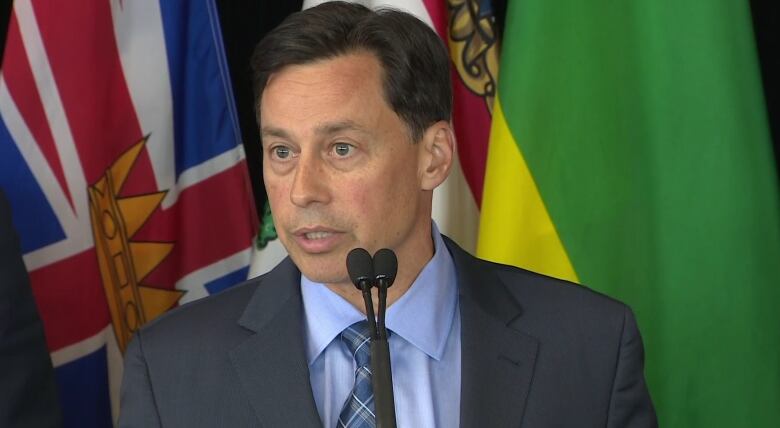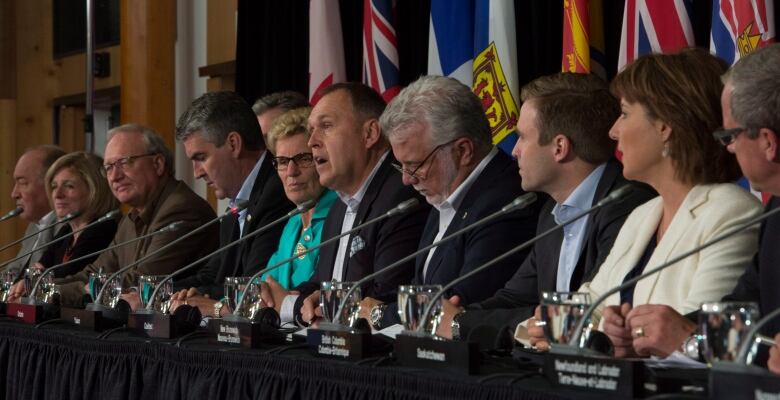Details of interprovincial free trade deal won't be public for months
Premiers in Whitehorse suggested mission accomplished, but nothing's final and some of it is only temporary

It could be months before Canadians learn what's really in and more importantly, out ofthe interprovincial free trade deal Canada's premiers announced in Whitehorse last Friday.
Not only is the Canada Free Trade Agreementnot finished, but at least one hard-fought-forsection has to be temporaryto avoid contradictingpreviouslyagreed-to international trade rules.
Nevertheless, words like "historic" and "unprecedented" were bandied about last week when an agreement in principle was announced, even as trade aficionados pointed outthe acronymis already taken a Continental Free Trade Area(also CFTA) is in the works for Africa in 2017.
- THE HOUSE | Feds expect provinces to ratify free trade deal next year, with booze in the mix
- Premiers reach 'unprecedented' Canadian free-trade deal in Whitehorse
The most important part of the agreement the "negative list" of what goods and services areexcluded remains a mystery.
Meanwhile, inconsistent regulations across provinces for everything from corporate registration to transportation safety remain. The agreement doesn't actually fix those, but provides a "mechanism to harmonize and reconcile" specific rules.
Ontario's minister of economic developmentchaired the negotiations earlier this summer that gavethe premiers something to work from at last week's Council of the Federation talks.
In a statement to CBC News, BradDuguidsaid he's "thrilled with the progress that was made" and explained the next step.

"The negotiating officials who have played an integral role in getting us to this point will now work to resolve the remaining technical issues, with the goal of submitting a fully finalized agreement for consideration and endorsement by premiers at their next meeting. This is likely to occur in the fall," he said.
A First Ministers meeting is expected in October, when Prime Minister JustinTrudeauwill join the premiers to finalize Canada's strategy for reducing carbon emissions.
Last week, the premierscalled for talks on a new health-care accordas well so thatagenda's really filling up.
"If that [meeting] unfolds as expected, a final legal scrub and translation would be the last necessary steps before the agreement enters force,"Duguidsaid.
Secret list
The deal was negotiated on a "negative list" basis jargon that means the deal liberalizes "everythingbut" specified exclusions.
Officials say they'veseen thelist of what other provinces and the federal government want excluded. They say it's long, but still an improvement.
But it can't be shared as theclich goes, "until everything's agreed, nothing's agreed." Leaking drafts ties the hands of those still at the table.
"Until the final details are ironed out, it would be premature to discuss details of the agreement," Duguid's office said. "The agreement will be published in full after it's finalized by the premiers, which is likely to be this fall."
Thewait until it's posted publicly will be months, not weeks, sources confirm.

Businessgroups like the Canadian Chamber of Commercewant resultsfaster andmore transparent decision-making about what regional differences are really necessary.
Bychamber estimates,internal trade barriers cost Canadians billions. This, in a country that was supposed to have enshrinedfree trade at Confederation.
"We're disappointed to have to wait longer for a concrete agreement, especially since it has taken 149 years to get this far," CEO PerrinBeatty said.
'Buy Alberta' protectionism
One of the biggest puzzlers coming out of Whitehorse was how the dealmakes provincial and municipal procurement a bit less free.
Facingadownturn in the oil and gas sector, Alberta Premier Rachel Notley'sgovernment wanted new spending and there could be lots,consideringinfrastructure repairs and rebuilds after recentnatural disasters to translateinto jobs for therecentlyunemployed.
Some $34 billion is set to roll out over the next five years $5 billion might be on the table to rebuild Fort McMurray alone.
Notley proposed a kind of"Buy America"-stylemove to favour local firms:up to 20 per cent of an evaluation could be based on "local benefits."
Multinational construction companies might need to set upAlberta offices to satisfy local requirements.
Provincesdiscussed what would constitute an Alberta resident for the purposes of satisfying employment conditions. It was a sensitive topic:many non-residentscommutedto work on oilsands projects and might want to return.
Alberta's proposal was hard to accept. It ran afoul oftheNew West Partnership trade deal with British Columbia andSaskatchewan. (Manitoba's in talks to join, too.) Its neighbours needed an exemption.
Plus, Alberta isn't the only province that needs more jobs.

Atlantic Canadian premiersstood up as a group and called ita deal-breaker. They were prepared to retaliate. They wantedan exemption, too.
That left only Ontario and Quebec on the receiving end of the protectionism.
To save the deal from collapse, Quebec agreed to take it.
Short-term advantage for Europe?
But Central Canada's disadvantagemay betemporary becauseAlberta's special arrangementcomes with a four-year sunset clause.
Premiers alsohad to consider what they'd already agreed to in the Canada-EUcomprehensive economic trade agreement (CETA.)
Oncethat deal is ratified and that's still an "if,"not necessarily a "when"provinces can't disadvantageEuropean companies.
Discriminating against an out-of-province bidcould trigger an unfair trade challenge, using the newlyrewritten investor-statedispute settlement (ISDS) processunderCETA.
Although 90 per cent of CETA might come into effect provisionally in 2017,the ISDSwas classified asshared jurisdiction in Europe. Federal government officials say it can't be used until all EU member states votein their respective legislatures.
Could a French or Germancompany have a biddingadvantage over one from Ontario?
Yesuntil the sunset date, anyway.
To paraphrase B.C. Premier Christy Clark on another topic: trade isfreer,but not completely free.












_(720p).jpg)


 OFFICIAL HD MUSIC VIDEO.jpg)
.jpg)



























































































